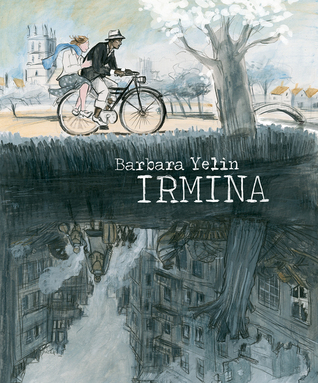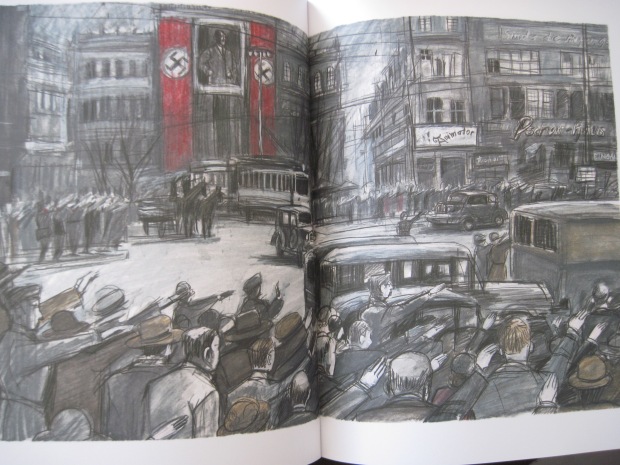 Barbara Yelin’s Irmina is one of the most visually stunning graphic novels I’ve ever come across. Not only that, but it’s based on a fascinating family story: after her grandmother’s death Yelin, a Munich-based artist, found a box of diaries and letters that told the story of a budding love affair that was not to be and charted a young woman’s gradual capitulation to Nazi ideology. How could her grandmother go from being a brave rule-breaker to a cowed regime supporter in just a few short years, she wondered? This fictionalized biography is her attempt to reconcile the ironies and hard facts of her ancestor’s life.
Barbara Yelin’s Irmina is one of the most visually stunning graphic novels I’ve ever come across. Not only that, but it’s based on a fascinating family story: after her grandmother’s death Yelin, a Munich-based artist, found a box of diaries and letters that told the story of a budding love affair that was not to be and charted a young woman’s gradual capitulation to Nazi ideology. How could her grandmother go from being a brave rule-breaker to a cowed regime supporter in just a few short years, she wondered? This fictionalized biography is her attempt to reconcile the ironies and hard facts of her ancestor’s life.
In 1934 Irmina von Behdinger arrives in London for a cultural exchange, attending a commercial school to train as a typist. One night she accompanies a friend to a fancy party and meets Howard, a young Barbados native she initially assumes to be a bartender. It turns out he actually has a scholarship to study law at Oxford. He’s learned, dignified and charming, and soon he and Irmina begin spending a lot of time together. Although she wishes she, too, could study at a proper university, women’s education is not valued in Germany.
Irmina and Howard’s carefree explorations of Oxford and London contrast with the increasingly bleak news coming from Germany about Hitler and his treatment of Jews. As her host family decries Nazism, Irmina tries to protest: “they are not MY Germans … this is politics! It doesn’t affect the average person.” She dreams of being an independent working woman and pursuing a relationship with Howard, but a change in her financial circumstances means she has to go back to Stuttgart instead. Promising to return to England as soon as she can raise some money, Irmina bids farewell to Howard at Portsmouth harbor in April 1935.
Back in Germany, she finds a translation job with the Ministry of War, hoping desperately to be transferred to the German consulate in London once she proves herself. But as the years pass and German relations with the rest of Europe grow strained, her dream seems increasingly unlikely. Having recently lost touch with Howard, she meets Gregor Meinrich, an architect for the SS, and gives up work when they marry and have a son. With the rare exception of a shocking event like Kristallnacht, it’s all too easy to ignore what’s happening to the nation’s Jews and absorb the propaganda that says they have earned their misfortune.
The novel is in three parts: London, Berlin and Barbados – Irmina gets a brief, late chance to see what her life might have been like with Howard. Yelin’s usual palette is muted and melancholy: grays, charcoal, slate blue, browns and flesh tones. However, in each section she chooses one signature color that adds symbolic flashes of life. For London it’s the bright blue of Irmina’s scarf, mirrored in Oxford’s sky and river, as well as in the occasional shopfront and lady’s dress.

In Berlin the red of the Nazi flag crops up in lipstick, dress patterns, flowers, wine and the décor of a ballroom. In the most poignant scene of all, though, red is equated with the spilling of Jewish blood. As a friend discusses what she doesn’t want to hear – “they’re taking them all to the East now, where they kill them” – Irmina is getting a jar of berry preserves down from a high shelf and drops it, spattering scarlet everywhere. On the other hand, to evoke the calm and natural beauty of 1980s Barbados, the featured hue is a seafoam green.
I was particularly impressed with the two-page spreads showing city scenes. They range from Impressionist fog to Modernist detail, reminding me of everything from Monet to Modigliani. Although the artwork stands out a bit more than the story, this still strikes me as a fresh look at the lives of ordinary Germans who were kept in the dark (by themselves and others) about Hitler’s activities. In an afterword, Dr. Alexander Korb, Director of the University of Leicester’s Stanley Burton Centre for Holocaust and Genocide Studies, reflects on Irmina’s motivation:
Irmina had a full range of possibilities. Yet the fact that she chose the Nazi path from the wide variety in front of her, encompassing feminism, internationality and individuality, makes her story typical of this time. It was just as typical that she failed to find happiness in fascism, like millions of others.
For the out-of-the-ordinary window onto Third Reich history and the excellent illustrations, I highly recommend Irmina to graphic novel lovers and newbies alike.
With thanks to the publisher, SelfMadeHero, for the free copy. Translated from the German by Michael Waaler.
My rating: 
This is the first time I have actually felt tempted to try a graphic novel. They just don’t do it for me, and I find it a very irritating way of ‘reading’. This one looks visually rewarding though, and with an absorbing plot. Have you made a convert, I wonder?
LikeLiked by 1 person
I would be absolutely delighted if my review convinced you to give graphic novels a try 🙂
LikeLiked by 1 person
Hmm. I’ve just looked it up. I may have to wait for the paperback edition …
LikeLike
Ah, I’m not surprised it’s expensive: SelfMadeHero issue beautiful, full-colour, large-format hardback books. I’m not sure if they do reissue in paperback. Maybe try at a library?
LikeLiked by 1 person
Yup… we still have our library. I’ll have a go.
LikeLike
The illustrations look wonderful in this book, and I’m intrigued by the story. It’s difficult territory and not an angle that gets explored much due to the sensitivity of the subject. However, with the popularity of the far right on the rise again across Europe, it would seem timely and vigilant to explore the reasons why people go on to develop fascist sympathies and how that process manifests over time.
LikeLiked by 1 person
That’s a great point, Sarah, and thank you for commenting.
LikeLiked by 1 person
This sounds excellent–thank you for putting it on my radar!
LikeLiked by 1 person
Great review.
Sent from my iPhone
>
LikeLiked by 1 person
This looks just beautiful. I’m going to make more of an effort this year with graphic novels and the like so this is going straight to the top of the list!
LikeLiked by 1 person
Hooray! I’ve gotten into them a lot more over the last few years. There’s some great ones out there.
LikeLike
Oh I love that artwork. So very beautiful!
LikeLike
I agree. You can tell the author is classically trained. I wish I had better art vocabulary to describe her skill!
LikeLiked by 1 person
That looks beautiful and fascinating, and the author has obviously absorbed different artistic styles then used them appropriately and effectively.
LikeLiked by 1 person
I’d like some advice Rebecca. After reading your review, I realised that graphic novels is something our reading group has never tackled. It’s a lot to do with lack of enthusiasm. Also, for price reasons, we need to make choices that are available in paperback, and in this genre, that seems to be a limitation in itself. Any suggestions – and suggestions that might help the group to tackle the task without a heavy heart?
LikeLiked by 1 person
Fun Home by Alison Bechdel and Can’t We Talk about Something More Pleasant? by Roz Chast are two of my absolute favourites. Both are “graphic memoirs” and I hope would be widely available, certainly the Bechdel at least.
LikeLiked by 1 person
I’m checking them out immediately!
LikeLiked by 1 person
[…] Irmina by Barbara Yelin: After her grandmother’s death Yelin, a Munich-based artist, found a box of diaries and letters that told the story of a budding love affair that was not to be and charted a young woman’s gradual capitulation to Nazi ideology. For the out-of-the-ordinary window onto Third Reich history and the excellent illustrations, I highly recommend this to graphic novel lovers and newbies alike. […]
LikeLike
[…] while American propaganda heaps shame on Germans for supporting Hitler. As with Barbara Yelin’s Irmina, though, there’s an acknowledgment here that it was never a clear-cut matter of pure evil or […]
LikeLike